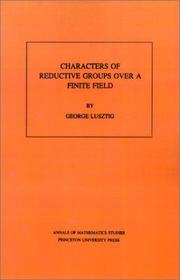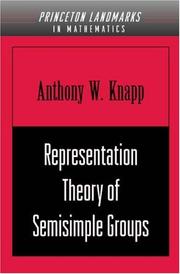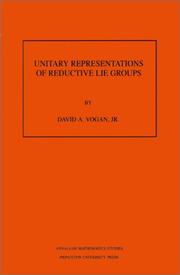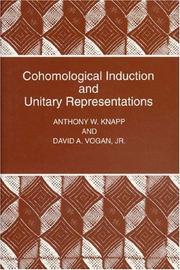| Listing 1 - 5 of 5 |
Sort by
|
Book
ISBN: 1280494654 9786613589880 1400842735 9781400842735 9780691154244 0691154244 9780691154251 0691154252 Year: 2012 Volume: 183 Publisher: Princeton : Princeton University Press,
Abstract | Keywords | Export | Availability | Bookmark
 Loading...
Loading...Choose an application
- Reference Manager
- EndNote
- RefWorks (Direct export to RefWorks)
Mumford-Tate groups are the fundamental symmetry groups of Hodge theory, a subject which rests at the center of contemporary complex algebraic geometry. This book is the first comprehensive exploration of Mumford-Tate groups and domains. Containing basic theory and a wealth of new views and results, it will become an essential resource for graduate students and researchers. Although Mumford-Tate groups can be defined for general structures, their theory and use to date has mainly been in the classical case of abelian varieties. While the book does examine this area, it focuses on the nonclassical case. The general theory turns out to be very rich, such as in the unexpected connections of finite dimensional and infinite dimensional representation theory of real, semisimple Lie groups. The authors give the complete classification of Hodge representations, a topic that should become a standard in the finite-dimensional representation theory of noncompact, real, semisimple Lie groups. They also indicate that in the future, a connection seems ready to be made between Lie groups that admit discrete series representations and the study of automorphic cohomology on "ients of Mumford-Tate domains by arithmetic groups. Bringing together complex geometry, representation theory, and arithmetic, this book opens up a fresh perspective on an important subject.
Mumford-Tate groups. --- Geometry, Algebraic. --- Algebraic geometry --- Geometry --- Hodge theory --- Mumford-Tate groups --- Deligne torus integer. --- Galois group. --- Grothendieck conjecture. --- Hodge decomposition. --- Hodge domain. --- Hodge filtration. --- Hodge orientation. --- Hodge representation. --- Hodge structure. --- Hodge tensor. --- Hodge theory. --- Kubota rank. --- Lie algebra representation. --- Lie group. --- Mumford-Tate domain. --- Mumford-Tate group. --- Mumford-Tate subdomain. --- Noether-Lefschetz locus. --- Vogan diagram method. --- Weyl group. --- abelian variety. --- absolute Hodge class. --- algebraic geometry. --- arithmetic group. --- automorphic cohomology. --- classical group. --- compact dual. --- complex manifold. --- complex multiplication Hodge structure. --- complex multiplication. --- endomorphism algebra. --- exceptional group. --- holomorphic mapping. --- homogeneous complex manifold. --- homomorphism. --- mixed Hodge structure. --- moduli space. --- monodromy group. --- natural symmetry group. --- oriented imaginary number fields. --- period domain. --- period map. --- polarization. --- polarized Hodge structure. --- pure Hodge structure. --- reflex field. --- semisimple Lie algebra. --- semisimple Lie group. --- Γ-equivalence classes.

ISBN: 0691083509 0691083517 1400881773 9780691083513 9780691083506 Year: 2016 Volume: 107 Publisher: Princeton, NJ : Princeton University Press,
Abstract | Keywords | Export | Availability | Bookmark
 Loading...
Loading...Choose an application
- Reference Manager
- EndNote
- RefWorks (Direct export to RefWorks)
This book presents a classification of all (complex)irreducible representations of a reductive group withconnected centre, over a finite field. To achieve this,the author uses etale intersection cohomology, anddetailed information on representations of Weylgroups.
512 --- Characters of groups --- Finite fields (Algebra) --- Finite groups --- Groups, Finite --- Group theory --- Modules (Algebra) --- Modular fields (Algebra) --- Algebra, Abstract --- Algebraic fields --- Galois theory --- Characters, Group --- Group characters --- Groups, Characters of --- Representations of groups --- Rings (Algebra) --- Algebra --- 512 Algebra --- Finite groups. --- Characters of groups. --- Addition. --- Algebra representation. --- Algebraic closure. --- Algebraic group. --- Algebraic variety. --- Algebraically closed field. --- Bijection. --- Borel subgroup. --- Cartan subalgebra. --- Character table. --- Character theory. --- Characteristic function (probability theory). --- Characteristic polynomial. --- Class function (algebra). --- Classical group. --- Coefficient. --- Cohomology with compact support. --- Cohomology. --- Combination. --- Complex number. --- Computation. --- Conjugacy class. --- Connected component (graph theory). --- Coxeter group. --- Cyclic group. --- Cyclotomic polynomial. --- David Kazhdan. --- Dense set. --- Derived category. --- Diagram (category theory). --- Dimension. --- Direct sum. --- Disjoint sets. --- Disjoint union. --- E6 (mathematics). --- Eigenvalues and eigenvectors. --- Endomorphism. --- Equivalence class. --- Equivalence relation. --- Existential quantification. --- Explicit formula. --- Explicit formulae (L-function). --- Fiber bundle. --- Finite field. --- Finite group. --- Fourier transform. --- Green's function. --- Group (mathematics). --- Group action. --- Group representation. --- Harish-Chandra. --- Hecke algebra. --- Identity element. --- Integer. --- Irreducible representation. --- Isomorphism class. --- Jordan decomposition. --- Line bundle. --- Linear combination. --- Local system. --- Mathematical induction. --- Maximal torus. --- Module (mathematics). --- Monodromy. --- Morphism. --- Orthonormal basis. --- P-adic number. --- Parametrization. --- Parity (mathematics). --- Partially ordered set. --- Perverse sheaf. --- Pointwise. --- Polynomial. --- Quantity. --- Rational point. --- Reductive group. --- Ree group. --- Schubert variety. --- Scientific notation. --- Semisimple Lie algebra. --- Sheaf (mathematics). --- Simple group. --- Simple module. --- Special case. --- Standard basis. --- Subset. --- Subtraction. --- Summation. --- Surjective function. --- Symmetric group. --- Tensor product. --- Theorem. --- Two-dimensional space. --- Unipotent representation. --- Vector bundle. --- Vector space. --- Verma module. --- Weil conjecture. --- Weyl group. --- Zariski topology.

ISBN: 0691090890 9780691090894 0691084017 1400883970 9780691084015 Year: 1986 Volume: 36 Publisher: Princeton (N.J.): Princeton university press
Abstract | Keywords | Export | Availability | Bookmark
 Loading...
Loading...Choose an application
- Reference Manager
- EndNote
- RefWorks (Direct export to RefWorks)
In this classic work, Anthony W. Knapp offers a survey of representation theory of semisimple Lie groups in a way that reflects the spirit of the subject and corresponds to the natural learning process. This book is a model of exposition and an invaluable resource for both graduate students and researchers. Although theorems are always stated precisely, many illustrative examples or classes of examples are given. To support this unique approach, the author includes for the reader a useful 300-item bibliography and an extensive section of notes.
Semisimple Lie groups. --- Representations of groups. --- Groupes de Lie semi-simples --- Représentations de groupes --- Semisimple Lie groups --- Representations of groups --- Semi-simple Lie groups --- Lie groups --- Group representation (Mathematics) --- Groups, Representation theory of --- Group theory --- Représentations de groupes --- 512.547 --- 512.547 Linear representations of abstract groups. Group characters --- Linear representations of abstract groups. Group characters --- Abelian group. --- Admissible representation. --- Algebra homomorphism. --- Analytic function. --- Analytic proof. --- Associative algebra. --- Asymptotic expansion. --- Automorphic form. --- Automorphism. --- Bounded operator. --- Bounded set (topological vector space). --- Cartan subalgebra. --- Cartan subgroup. --- Category theory. --- Characterization (mathematics). --- Classification theorem. --- Cohomology. --- Complex conjugate representation. --- Complexification (Lie group). --- Complexification. --- Conjugate transpose. --- Continuous function (set theory). --- Degenerate bilinear form. --- Diagram (category theory). --- Dimension (vector space). --- Dirac operator. --- Discrete series representation. --- Distribution (mathematics). --- Eigenfunction. --- Eigenvalues and eigenvectors. --- Existence theorem. --- Explicit formulae (L-function). --- Fourier inversion theorem. --- General linear group. --- Group homomorphism. --- Haar measure. --- Heine–Borel theorem. --- Hermitian matrix. --- Hilbert space. --- Holomorphic function. --- Hyperbolic function. --- Identity (mathematics). --- Induced representation. --- Infinitesimal character. --- Integration by parts. --- Invariant subspace. --- Invertible matrix. --- Irreducible representation. --- Jacobian matrix and determinant. --- K-finite. --- Levi decomposition. --- Lie algebra. --- Locally integrable function. --- Mathematical induction. --- Matrix coefficient. --- Matrix group. --- Maximal compact subgroup. --- Meromorphic function. --- Metric space. --- Nilpotent Lie algebra. --- Norm (mathematics). --- Parity (mathematics). --- Plancherel theorem. --- Projection (linear algebra). --- Quantifier (logic). --- Reductive group. --- Representation of a Lie group. --- Representation theory. --- Schwartz space. --- Semisimple Lie algebra. --- Set (mathematics). --- Sign (mathematics). --- Solvable Lie algebra. --- Special case. --- Special linear group. --- Special unitary group. --- Subgroup. --- Summation. --- Support (mathematics). --- Symmetric algebra. --- Symmetrization. --- Symplectic group. --- Tensor algebra. --- Tensor product. --- Theorem. --- Topological group. --- Topological space. --- Topological vector space. --- Unitary group. --- Unitary matrix. --- Unitary representation. --- Universal enveloping algebra. --- Variable (mathematics). --- Vector bundle. --- Weight (representation theory). --- Weyl character formula. --- Weyl group. --- Weyl's theorem. --- ZPP (complexity). --- Zorn's lemma.

ISBN: 0691084815 0691084823 1400882389 9780691084824 9780691084817 Year: 1987 Publisher: Princeton : Princeton University Press,
Abstract | Keywords | Export | Availability | Bookmark
 Loading...
Loading...Choose an application
- Reference Manager
- EndNote
- RefWorks (Direct export to RefWorks)
This book is an expanded version of the Hermann Weyl Lectures given at the Institute for Advanced Study in January 1986. It outlines some of what is now known about irreducible unitary representations of real reductive groups, providing fairly complete definitions and references, and sketches (at least) of most proofs. The first half of the book is devoted to the three more or less understood constructions of such representations: parabolic induction, complementary series, and cohomological parabolic induction. This culminates in the description of all irreducible unitary representation of the general linear groups. For other groups, one expects to need a new construction, giving "unipotent representations." The latter half of the book explains the evidence for that expectation and suggests a partial definition of unipotent representations.
Lie groups --- Representations of Lie groups --- Lie groups. --- Representations of Lie groups. --- 512.81 --- Groups, Lie --- Lie algebras --- Symmetric spaces --- Topological groups --- 512.81 Lie groups --- Abelian group. --- Adjoint representation. --- Annihilator (ring theory). --- Atiyah–Singer index theorem. --- Automorphic form. --- Automorphism. --- Cartan subgroup. --- Circle group. --- Class function (algebra). --- Classification theorem. --- Cohomology. --- Commutator subgroup. --- Complete metric space. --- Complex manifold. --- Conjugacy class. --- Cotangent space. --- Dimension (vector space). --- Discrete series representation. --- Dixmier conjecture. --- Dolbeault cohomology. --- Duality (mathematics). --- Eigenvalues and eigenvectors. --- Exponential map (Lie theory). --- Exponential map (Riemannian geometry). --- Exterior algebra. --- Function space. --- Group homomorphism. --- Harmonic analysis. --- Hecke algebra. --- Hilbert space. --- Hodge theory. --- Holomorphic function. --- Holomorphic vector bundle. --- Homogeneous space. --- Homomorphism. --- Induced representation. --- Infinitesimal character. --- Inner automorphism. --- Invariant subspace. --- Irreducibility (mathematics). --- Irreducible representation. --- Isometry group. --- Isometry. --- K-finite. --- Kazhdan–Lusztig polynomial. --- Langlands decomposition. --- Lie algebra cohomology. --- Lie algebra representation. --- Lie algebra. --- Lie group action. --- Lie group. --- Mathematical induction. --- Maximal compact subgroup. --- Measure (mathematics). --- Minkowski space. --- Nilpotent group. --- Orbit method. --- Orthogonal group. --- Parabolic induction. --- Principal homogeneous space. --- Principal series representation. --- Projective space. --- Pseudo-Riemannian manifold. --- Pullback (category theory). --- Ramanujan–Petersson conjecture. --- Reductive group. --- Regularity theorem. --- Representation of a Lie group. --- Representation theorem. --- Representation theory. --- Riemann sphere. --- Riemannian manifold. --- Schwartz space. --- Semisimple Lie algebra. --- Sheaf (mathematics). --- Sign (mathematics). --- Special case. --- Spectral theory. --- Sub"ient. --- Subgroup. --- Support (mathematics). --- Symplectic geometry. --- Symplectic group. --- Symplectic vector space. --- Tangent space. --- Tautological bundle. --- Theorem. --- Topological group. --- Topological space. --- Trivial representation. --- Unitary group. --- Unitary matrix. --- Unitary representation. --- Universal enveloping algebra. --- Vector bundle. --- Weyl algebra. --- Weyl character formula. --- Weyl group. --- Zariski's main theorem. --- Zonal spherical function. --- Représentations de groupes de Lie --- Groupes de lie --- Representation des groupes de lie

ISBN: 0691037566 1400883938 Year: 1995 Publisher: Princeton : Princeton University Press,
Abstract | Keywords | Export | Availability | Bookmark
 Loading...
Loading...Choose an application
- Reference Manager
- EndNote
- RefWorks (Direct export to RefWorks)
This book offers a systematic treatment--the first in book form--of the development and use of cohomological induction to construct unitary representations. George Mackey introduced induction in 1950 as a real analysis construction for passing from a unitary representation of a closed subgroup of a locally compact group to a unitary representation of the whole group. Later a parallel construction using complex analysis and its associated co-homology theories grew up as a result of work by Borel, Weil, Harish-Chandra, Bott, Langlands, Kostant, and Schmid. Cohomological induction, introduced by Zuckerman, is an algebraic analog that is technically more manageable than the complex-analysis construction and leads to a large repertory of irreducible unitary representations of reductive Lie groups. The book, which is accessible to students beyond the first year of graduate school, will interest mathematicians and physicists who want to learn about and take advantage of the algebraic side of the representation theory of Lie groups. Cohomological Induction and Unitary Representations develops the necessary background in representation theory and includes an introductory chapter of motivation, a thorough treatment of the "translation principle," and four appendices on algebra and analysis.
512.73 --- Harmonic analysis --- Homology theory --- Representations of groups --- Semisimple Lie groups --- Semi-simple Lie groups --- Lie groups --- Group representation (Mathematics) --- Groups, Representation theory of --- Group theory --- Cohomology theory --- Contrahomology theory --- Algebraic topology --- Analysis (Mathematics) --- Functions, Potential --- Potential functions --- Banach algebras --- Calculus --- Mathematical analysis --- Mathematics --- Bessel functions --- Fourier series --- Harmonic functions --- Time-series analysis --- Cohomology theory of algebraic varieties and schemes --- 512.73 Cohomology theory of algebraic varieties and schemes --- Lie algebras. --- Lie, Algèbres de. --- Semisimple Lie groups. --- Representations of groups. --- Homology theory. --- Harmonic analysis. --- Représentations d'algèbres de Lie --- Representations of Lie algebras --- Abelian category. --- Additive identity. --- Adjoint representation. --- Algebra homomorphism. --- Associative algebra. --- Associative property. --- Automorphic form. --- Automorphism. --- Banach space. --- Basis (linear algebra). --- Bilinear form. --- Cartan pair. --- Cartan subalgebra. --- Cartan subgroup. --- Cayley transform. --- Character theory. --- Classification theorem. --- Cohomology. --- Commutative property. --- Complexification (Lie group). --- Composition series. --- Conjugacy class. --- Conjugate transpose. --- Diagram (category theory). --- Dimension (vector space). --- Dirac delta function. --- Discrete series representation. --- Dolbeault cohomology. --- Eigenvalues and eigenvectors. --- Explicit formulae (L-function). --- Fubini's theorem. --- Functor. --- Gregg Zuckerman. --- Grothendieck group. --- Grothendieck spectral sequence. --- Haar measure. --- Hecke algebra. --- Hermite polynomials. --- Hermitian matrix. --- Hilbert space. --- Hilbert's basis theorem. --- Holomorphic function. --- Hopf algebra. --- Identity component. --- Induced representation. --- Infinitesimal character. --- Inner product space. --- Invariant subspace. --- Invariant theory. --- Inverse limit. --- Irreducible representation. --- Isomorphism class. --- Langlands classification. --- Langlands decomposition. --- Lexicographical order. --- Lie algebra. --- Linear extension. --- Linear independence. --- Mathematical induction. --- Matrix group. --- Module (mathematics). --- Monomial. --- Noetherian. --- Orthogonal transformation. --- Parabolic induction. --- Penrose transform. --- Projection (linear algebra). --- Reductive group. --- Representation theory. --- Semidirect product. --- Semisimple Lie algebra. --- Sesquilinear form. --- Sheaf cohomology. --- Skew-symmetric matrix. --- Special case. --- Spectral sequence. --- Stein manifold. --- Sub"ient. --- Subalgebra. --- Subcategory. --- Subgroup. --- Submanifold. --- Summation. --- Symmetric algebra. --- Symmetric space. --- Symmetrization. --- Tensor product. --- Theorem. --- Uniqueness theorem. --- Unitary group. --- Unitary operator. --- Unitary representation. --- Upper and lower bounds. --- Verma module. --- Weight (representation theory). --- Weyl character formula. --- Weyl group. --- Weyl's theorem. --- Zorn's lemma. --- Zuckerman functor.
| Listing 1 - 5 of 5 |
Sort by
|

 Search
Search Feedback
Feedback About
About Help
Help News
News